Sony A95K Reviewed at $3,999.00 (55")
Product Name: Sony A95K
Product Description: 2022 4K QD-OLED TV
-
Design - 9.2/10
9.2/10
-
Video Quality - 9.5/10
9.5/10
-
Ports & Connectivity - 9.2/10
9.2/10
-
OS, Apps and Features - 9.5/10
9.5/10
-
Price / Quality - 8.6/10
8.6/10
Summary
Reviewed at $3,999.00 (55″)
Pros
- Extremely accurate colors
- Amazing HDR brightness
- Perfect blacks
- Dolby Vision and DTS support
Cons
- Not as bright as the Samsung S95B
- Only 2 HDMI 2.1 ports
- No BFI at 120Hz
- Questionable stand design
Cheapest Places to Buy :
*We are a reader-supported website. When you buy through links on our site, we may earn a small affiliate commission at no extra cost to you. Home Media Entertainment does not accept money for reviews.*
2022 was a special year as we saw the release, for the first time, of QD-OLED equipped TVs which is the natural progression and evolution of OLED that has been the king of image quality for a few good years now. After testing the Samsung S95B we got a pretty good idea of what QD-OLED could do, so now in our Sony A95K review we will be looking at the second of the QD-OLEDs released this year and determine what similarities and what differences the two competing brands have.

With the arrival of QD-OLED it seems that Sony had to change a bit their release lineup. The A95K obviously takes the top spot as their newest flagship but after that things become a bit more complicated as the A90K, that is supposed to replace the A90J comes only in 42″ and 48″ sizes. As such the next new release is the A80K. And for that reason, in case you are wondering, Sony kept the 2021 A90J in circulation for one more year in order to bridge the gap between the A95K and the A80K.
As for the A95K in particular, let’s see quickly what do we actually get here. The Sony A95K uses a 120Hz QD-OLED panel, comes with Cognitive Processor XR and Sony’s most advanced Acoustic Surface Audio+ system. There is Dolby Atmos, DTS and Dolby Vision support, two HDMI 2.1 ports with VRR out of the box, and is packed with the latest Google TV platform including plenty of extras like Chromecast, Airplay 2 and Homekit, Bravia Core, voice control, Netflix calibrated mode, IMAX Enhanced, Calman Ready and Bravia Cam support.
In terms of extras and features the A95K comes with the standard set that most higher tier Sony TVs have like the A80K OLED we saw recently. The major difference here is the QD-OLED panel and what it has to offer. Is it on the same level as Samsung’s S95B? Let’s start our analysis to find out…
Design
QD-OLED retains some of the design characteristics of OLED TVs and as such the A95K is an extremely thin TV that has an unusual stand compared to most other OLED offerings from other manufacturers.
One thing that made an impression was that while most OLED TVs from all manufacturers use an extremely thin panel along with the plastic box that houses all electronics at the back of it, the A95K actually has a slightly curvy panel at the back that we usually see in LED LCD TVs. It is still very thin, much more than any non OLED but this design change seems to be happening in many Sony releases this year as the A80K had also the same characteristic.
Looking at the TV at the front we see that it comes with very thin borders measured at 0.30″ (0.8 cm) while overall thickness was just 1.7″ (4.3 cm) making it even thinner than the A80K.
The back of the TV is also different, the grid style design is preserved but gone are the diagonal grooves we had seen in previous Sony TVs while the ports are separated into two groups with one looking sideways and the other downwards. The power connector is still isolated on the left side while the VESA mounting holes and a couple of speaker grilles are the only other elements visible. Also gone is the XR logo that was engraved in the middle of some 2021 top tier TVs.
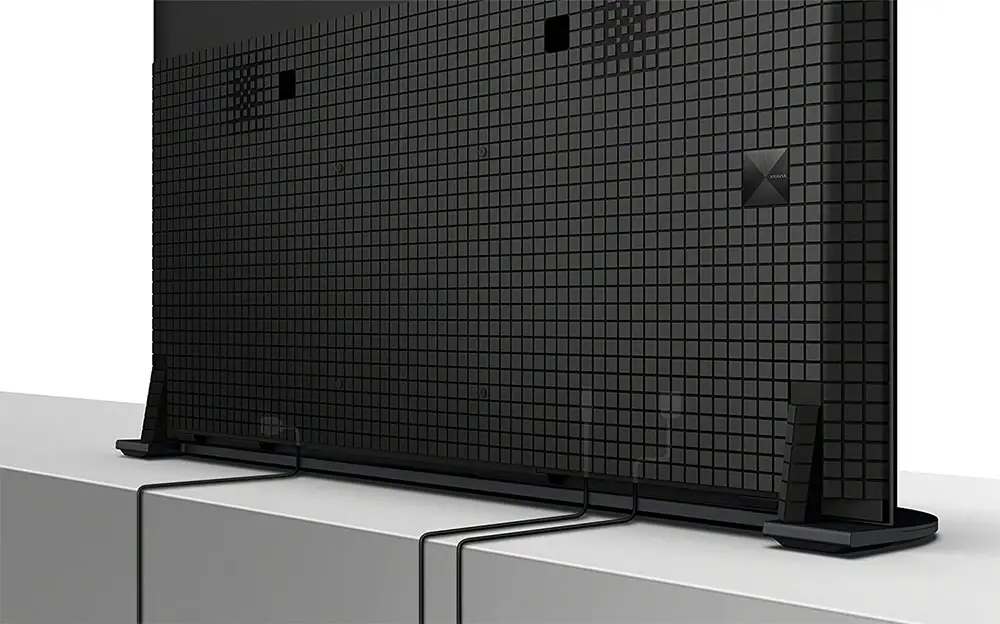
What is unique in the A95K is surely the stand. It doesn’t follow neither the central stand or the bench type design and instead Sony created a flat stand that extends the entire length of the TV and can be placed in two different positions. Either at the front or the back.
Although this is personal taste what we didn’t like was the fact that this type of stand does not leave any space between the furniture and the panel. As a result you are unable of placing a soundbar under it unless you resort in some short of special furniture or extra stand. As it is the TV panel sits entire on the surface and surely looks a bit strange if you are used to so many TVs leaving some breathing space under the panel.
Lastly as far as cable management is concerned you get the usual Sony treatment as there is none. No grooves to drive the cables through and no special clips that can be attached to the legs and keep all cables together. At least with the TV sitting flat on the furniture these does not show at all.
As for the new updated remote, this feels simpler, less cluttered and easier to handle. Design wise the remote of the A95K is no different from all other Sony releases in 2022. The only aesthetic difference is that this comes with a brushed silver finish while some other premium models use one made of brushed black finish. The one that comes with the A95K has backlight functionality and special sensors that illuminates the buttons when the remote is moved.

We really liked Sony’s 2021 remote but to be honest it had too many buttons with many of them never to be used. So making the remote smaller and simpler was the right thing to do and we do love what they have come up with for 2022.
The Sony A95K is surely a premium looking TV but the stand will surely make a lot of consumers dislike it. A more usual stand would definitely be more practical than this so hopefully in future releases we will see QD-OLEDs with more traditional designs.
Video Quality
Processor technology used
In terms of image processing the A95K uses the same Cognitive Processor XR which is the same chip used across most premium and top tier TVs from Sony. As is the case with all new models we don’t know if this is exactly the same chip as it was last year as Sony is secretive about anything that has to do with their chips but judging by its specs and features it seems to be the same.
The Cognitive Processor XR divides the screen into hundreds of zones and recognizes individual objects in these zones better than ever before. What’s more, it can cross-analyze around a few hundred thousand different elements that make up a picture in a second like focal points, contrast, colors, motion and clarity and determine ways in order to improve the end result even more.

As always in order to determine the up-scaling capabilities of the TV we go through various content in different resolutions and quality. These vary from low quality broadcasting material, 480p, 720p and 1080p content. The A95K up-scaled everything with no obvious artifacts from the process and essentially behaved similarly to other top tier Sony units we had seen before.
But the new processor is not only good at providing excellent picture quality as it has also a few interesting audio features. Being included in the XR Sound suite the processor supports XR Sound Position in order for the audio to match exactly what is displayed on screen through the included Acoustic Surface Audio+ system while XR Surround is responsible for creating a virtual 3D environment in order to up the immersion even more.
Also with the new Bravia Cam the built-in Ambient Optimization Pro can calibrate the audio no matter your viewing position. But more on the audio in the appropriate section.
As the A95K comes with the Cognitive Processor XR, the TV comes with all the bells and whistles we have seen from Sony using in all TVs with the same chip, so nothing new here really.

Lighting technology used
The main strength of the A95K, and a major step forward in panel technology in general, is the use for the first time of Samsung’s Display QD-OLED panel which is exactly the same technology being used in Samsung’s own S95B.
Traditional OLED panels feature self emitting pixels and as a result these TVs have no need for a backlight as we see in LED LCD models. Being able to control it’s individual pixels has many advantages with the most obvious ones being the extremely accurate light control and the infinite contrast they have with deep blacks being a sight that needs to be seen to be believed.
On the other hand the problem with OLEDs is that they cannot reach the high brightness output of LED LCD TVs. This has been a problem since the inception of OLED panels and although there have been some developments like Panasonic’s solution to add a heatsink in order to push the panel more without damaging it, OLEDs still remained a distant second when it came to peak brightness output.
And this is where QD-OLED comes into play as this hybrid design is meant to take all the strengths OLED has and with the use of Quantum Dot technology boost the brightness and color reproduction in levels that were not possible with the OLED panels available till now.
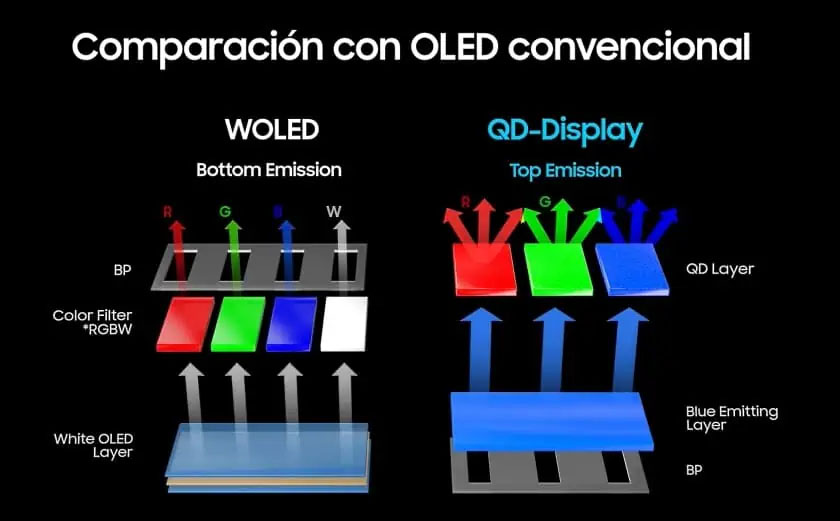
We are not going to analyze very much how this technology works as this is a subject for another article but in theory the A95K, with the use of the new QD-OLED panel is meant to have superior brightness output, higher color coverage than any traditional OLED panel so far, better viewing angles and better image reflection handling. And if Samsung’s S95B was any indication then we also expect similar performance from the A95K.
If there is one thing we noticed during our time with the A95K, it is that due to the unusual subpixel structure of QD-OLED you may notice some green or red lines in content that have black bars on top or bottom of the screen. Also due to this, using the A95K as a PC monitor may not have the most clear text among the top tier models. This is not a problem of the A95K specifically as the Samsung S95B had exactly the same problem and it stems from the panel’s subpixel structure, so in essence this is a disadvantage of the QD-OLED panel itself.
In our blooming test patterns the A95K did amazing and as good as any OLED TV we had tested before. Being able to see a bright object in a completely dark background and don’t have any blooming on sight is a real treat and shows the strength of QD-OLED technology.
As we said in our S95B review, the QD-OLED technology seems to be the future and we see this replacing traditional OLED TVs in the next few years. And with that in mind we cannot wait to see what the future holds.

Brightness / Contrast
Onto our brightness tests now and it will be interesting to see how Sony’s QD-OLED offering fares compared to Samsung’s competing flagship.
For this test we used the Custom mode, which tends to be the most accurate one in many Sony TVs, Expert 1 color tone and Brightness set to max. In our SDR brightness test over a 10% white window we got 425 nits, which is good enough for SDR content but we cannot say we were amazed by this number as we have seen much better.
On our HDR brightness test we switched to Expert 2 color tone and over a 10% white window we got 994 nits of brightness which is amazing for an OLED TV.
As with all OLED TVs, the A95K comes with an Automatic Brightness Limiter (ABL) that lowers the overall brightness of the screen when large parts of it become very bright. This may not be very obvious when watching a movie for example but it can be noticed more with bright static images or if you use the TV as a computer monitor. And Sony’s implementation of this system is a bit more aggressive compared to some other brands we had tested before.
Unfortunately these numbers indicate that the A95K is slightly less bright than the Samsung S95B although both of them are really close and with real world content the difference is hard to spot.

Brightness levels followed the EOTF reference values almost perfectly up to its relatively sharp roll-off point which means that some details may be lost. Just keep in mind that in order for the TV to follow the curve so accurately you have to use its Gradation Preferred tone mapping as the other options are far less accurate and overall more bright than it should.
As for contrast, having an QD-OLED panel means that the A95K can switch off it’s pixels entirely meaning it gains almost infinite contrast ratio resulting in true deep blacks compared to greyish blacks we see in many LCD models while it’s panel uniformity was almost perfect from what we saw.
The Sony A95K may not be as bright as Samsung’s offering but still is one of the brightest OLEDs to this day. On the other hand due to Sony’s better tone mapping the A95K manages to produce images that while less bright are equally impressive.
Viewing angles
OLED TVs always had the upper hand when it came to viewing angles and it seems that with QD-OLED things got even better. To be honest here, while we do like that QD-OLED managed to push the viewing angles to even better values this was never a real problem to begin with so from all the advantages this new panel has maybe this one is the least important one.
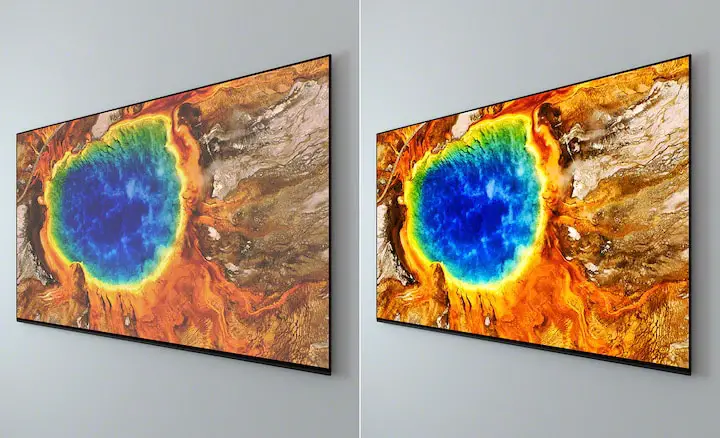
In general, light has a linearity, so when viewing a display, it affects the brightness or color depending on which angle you look at the screen. With the characteristic of QD-OLED that emits light uniformly in all directions, the QD display provides optimal image quality by delivering uniform luminance and color regardless of viewing angle.
As for the A95K in specific, the TV managed to maintain excellent picture quality at angles that could reach 70 degrees from the center and thus making it perform on par with what we measured in the Samsung S95B which is not all that surprising given that both TVs use the same panel technology. More than 70 degrees and the image would degrade a bit but these are extreme angles we are talking about and most would never watch in such conditions.
As a result the A95K, along with the S95B, can be considered the best TV as far as viewing angles is concerned. If you want this for family use where many members will watch from different angles this is as good as it can get.
HDR support
As far as HDR protocols Sony likes to include the same across the entire lineup, either it is top tier or lower end TV. So here things are pretty much the same as the rest of the 2022 offerings.

In total the A95K features the standard trio of HDR protocols that include the basic HDR10 which is required for 4K UHD playback, HLG that is used in broadcasting and lastly the more advanced Dolby Vision that uses dynamic metadata and offers the best quality from the three available.
If you don’t care about HDR10+ then you shouldn’t really worry about it. Dolby Vision has far more support although HDR10+ seems to be getting some traction both from online streaming services like Amazon Prime and in the UHD format.
If you really want to have both HDR10+ and Dolby Vision then you will have to look at some other brand like Hisense or depending where you live to Panasonic or even Philips as none of the big three (LG, Samsung and Sony) support all of them.
Unfortunately it seems that after so many years none of the big three is going to offer full HDR support forcing consumers to choose what they want the most instead of offering all in a single package.

Color coverage
The A95K, as with some other premium Sony TVs, is equipped with certain tech in order to allow it to display deeper and more lifelike colors. As such Sony has used XR Triluminos Max technology in combination with XR Color technology which is included in their XR Picture suite. This is a step above the Triluminos Pro tech that is included in all premium Sony TVs that come with the Cognitive Processor XR and the XR Picture suite.
According to our measurements the TV has 100% coverage of the DCI-P3 color space which is perfect. On the wider REC.2020 color space we got a coverage of 89% which is extremely good and one of the best we have measured so far. Keep in mind that we took these measurements with the Gradation Preferred tone mapping setting.
Overall the Sony A95K seems to beat the Samsung S95B here. And this shows that Sony’s TV goes for more color accuracy than higher brightness that ultimately makes a more impressive but also less accurate image.
Before calibration the A95K had very good color accuracy but not without a few problems. White balance needed some adjustment but most colors had values below the DeltaE limit of three. But both of them can be corrected after calibration making the final image quality almost perfect.
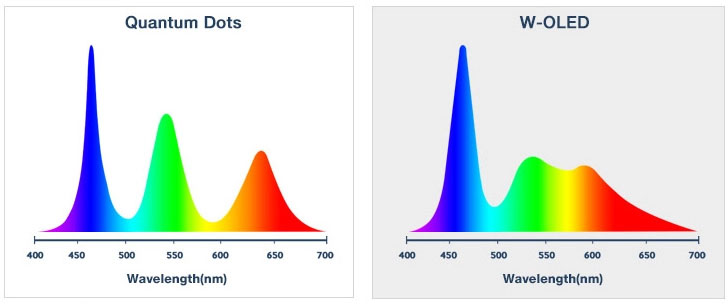
Color gradients were amazing with almost no visible banding at all. There is also a Smooth Gradation feature in case you notice some but you are going to loose some fine detail if enabled as is always the case with this feature.
Motion performance
We move on to our motion performance tests and the A95K behaved very close to some other Sony OLEDs we had tested lately. The TV uses a 120Hz panel along with Sony’s XR OLED Motion tech which is the company’s motion interpolation feature included in the XR Picture feature set of their Cognitive Processor XR.
You have the option to use either the standard motion interpolation system or use the Black Frame Insertion (BFI) interpolation that is adding black frames in between individual frames and can potentially smooth out motion. BFI can be enabled, as usual in Sony TVs, by turning Clearness to max if you use the Custom setting in the MotionFlow menu. Unfortunately BFI works only with 60fps content so you cannot use it for 4K@120Hz gaming.
The TV behaved exactly as we were expecting it to. With fast panning shots the TV interpolated very efficiently but not without some artifacts becoming visible. But if you compare it with some other interpolation systems, Sony’s implementation worked much better, at least with the A95K. In all other, slower paced scenes interpolation worked wonderfully without any blur of judder visible.

Also the A95K presented 24p content without any bothering judder. OLED technology suffers from almost instantaneous pixel response time so you may notice some stuttering that can be fixed with engaging a low setting motion interpolation. Just make sure you go easy on this in order to avoid the Soap Opera Effect.
From the content we tried out on the TV we can say that the A95K is surely Sony’s best when it comes to motion performance in their OLED category.
Input lag
Onto our input lag tests next and here we are expecting to see good values overall. After all most TVs nowadays, no matter their price range, are doing exceptionally good in this part.
According to our measurements the A95K measured an average of 17.0ms input lag in both 1080p and 4K resolutions at 60Hz with the use of Game mode. At 120Hz we measured 9.1ms in both 1080p and 4K resolutions which is amazing and low enough for all kinds of gamers either it be casual or hardcore ones.
These numbers are great but still not as good as the ones we measured in our Samsung S95B review. But even as such, with such low figures gaming can really be a pleasure, just make sure you use the available Game mode as outside that the input lag will greatly increase to around 156ms which can still can be fine for slow paced games but not good at all for fast action online gaming.

We should also not forget to mention that the TV supports Auto Low Latency Mode (ALLM) that can be used with any devices that support that like the PS5 and Xbox consoles and can greatly benefit users. As with all Sony TVs there is no HGiG mode but we do get Auto Genre Picture Mode and Auto HDR Tone Mapping which are Playstation 5 specific features.
Thankfully, this year the A95K comes with VRR support out of the box unlike 2021 Sony TVs that we had to wait for an update. HDMI Forum VRR and G-Sync are supported but unfortunately not FreeSync. Sony is not supporting that in any of their releases so don’t except that anytime soon.
One thing that we noticed is that while the Samsung S95B supports 144Hz the Sony A95K does not. So if you really want such high frame rates in your QD-OLED then the Samsung is your only choice for this year.
Before closing this part of our review we connected our PS5 to the TV and tested both Astro’s Playground and Call of Duty: Vanguard which come with VRR support. Our time with them didn’t showcase any problems at all. VRR engaged normally, response times were very low and all our commands registered immediately on screen. To summarize, we had a perfect gaming experience even though the Samsung S95B offers even more when it comes to gaming.

Image quality impressions
From all the above we can say with certainty that the Sony A95K is one of the best TVs you can get in 2022 in terms of image quality. It has amazing color accuracy, great HDR brightness for an OLED TV, excellent viewing angles, solid upscaling and motion performance and strong gaming capabilities.
It may not be the brightest in SDR content but surely most will not be interested in such when buying such a premium TV. In terms of gaming it’s missing some features that competing brands are offering like FreeSync and 144Hz while it only features two HDMI 2.1 instead of four that we see in LG and Samsung TVs the last few years.
Audio Quality
Onto the sound now. When it comes to audio Sony has developed several technologies that uses in their TVs and the one that is included in the A95K is their most advanced one called Acoustic Surface Audio+. This is the same system that is being used in the A80K but with a slightly different configuration applied here.
This system basically uses actuators at the back of the panel that vibrate and use the whole panel as a huge membrane and thus create sound. This way it seems like audio is coming from within the screen giving you a better sense of realism.
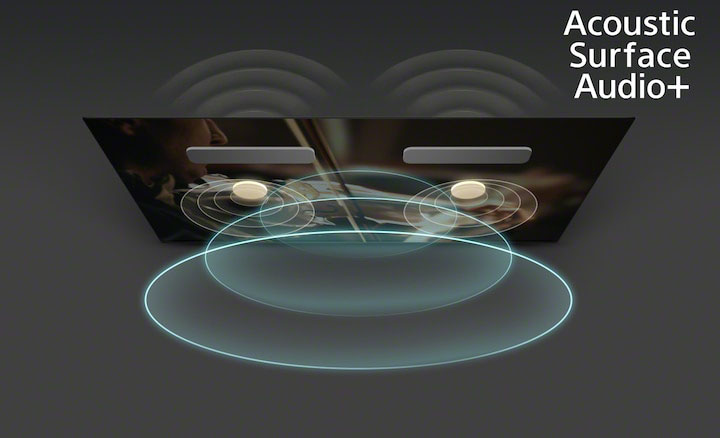
The A95K is using two actuators and two subwoofers in this system. In comparison the A80K is using three actuators so it seems that the A95K is using the same configuration we saw in the 2021 A80J. The difference with real world content may not be so dramatic as all these systems have relatively limited capabilities no matter what manufacturers do.
Power output across all actuators and subwoofers is at 20W + 20W + 10W + 10W.
There is support for Dolby Audio, Dolby Atmos and DTS Digital Surround sound but as always even if there is support for these, the final audio output leaves a lot to be desired and cannot even come close to a real surround system.
Also keep in mind that Sony is one of the few companies that still supports DTS and can even pass-through both Dolby Atmos and DTS:X signals from its eARC port so if this important to you then the Sony is your only choice from the big three (Samsung, LG, Sony).
The inclusion of the XR Cognitive Processor has allowed the A95K to include a few more advanced technologies which is the XR Sound suite. This includes the XR Sound position which with the help of the Acoustic Surface Audio+ technology makes sound originate from the exact spot on the screen making audio so much more realistic.
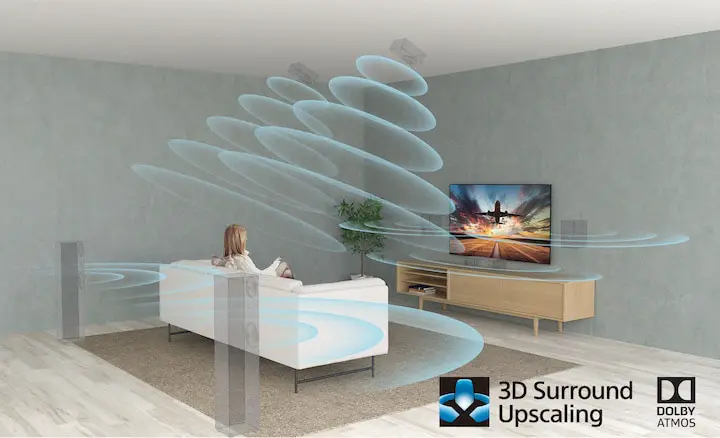
Also with XR Surround the A95K is using 3D surround upscaling in order to create a more immersive virtual surround environment. As with most TVs that include some short of virtual tech, the A95K does not offer true surround activity as there are no real rear speakers to begin with. As such the action is entirely front oriented.
Before closing this part we should mention that the A95K also features Sony’s Acoustic Auto calibration in order to get the best audio performance no matter your sitting position. This can be used in combination with the new Bravia Cam as it will detect where you sit in the room and calibrate the audio accordingly.
Overall the A95K offers what you should expect from a modern flat TV. It is enough for most casual use but if you really want to pair the amazing image with equally good sound we strongly suggest you go for a good quality soundbar or even better for a dedicated surround system. It’s a pity to have such an expensive flagship and not an audio system that can do real justice to what you see on screen.
Ports and Connectivity
Strangely enough the ports layout of the A95K is not the same as some other Sony OLEDs, like the A80K that happened to have all ports looking sideways but rather has the same design as some LED LCD units like the Sony X95K. As such there are two groups of ports available with some of them looking sideways and the rest are looking downwards.
The group looking sideways includes a Remote IR input, a AV input that needs a special adapter, a USB port and a single HDMI along with a small switch at the bottom for turning on and off the built-in microphone. The only difference in the A95K is that here we get an additional center speaker input at the top that was missing in the X95K.
On the other group looking downwards we get the antenna/cable port, an Ethernet port for connecting to a local network, a digital optical output, an RS-232 jack, three more HDMI ports and another USB.
Again there is no headphones output and there are only two USB ports instead of three that was available in previous years. Not big omissions, and this seems to become the standard in most new releases, but nevertheless we have to mention it.
Sony, unlike some of the other big manufacturers, actually provide a USB 3.0 port in most of their TVs, even the most low cost ones. Usually manufacturers don’t seem very fond of using the newer USB ports and rely mostly on the archaic 2.0 version even for many of their top premium models so this is definitely a plus and good for Sony that decided to do the obvious.
Also another thing to mention is that, as with all Sony TVs, we get two HDMI 2.1 ports along with two more older HDMI 2.0 ones. Although some other manufacturers. like LG or Samsung, offer more HDMI 2.1 ports at least two are better than one.
The problem here is that one of them is also the one with ARC/eARC functionality so if you plan on using that then you are left with a single HDMI 2.1 port. In general all TVs that feature only two ports use Mediatek’s SoC but at least the HDMI 2.1 ports in the A95K provide full 48Gbps bandwidth in order to allow high frame rate gaming and all HDMI 2.1 gaming features.
The HDMI 2.1 ports of the A95K support ARC, eARC, HFR, ALLM and VRR. With VRR you should know that it is supported out of the box, something that applies for all 2022 models, but only HDMI Forum VRR and G-Sync are available. FreeSync VRR is not supported in any Sony TV so far.
Also we are disappointed to see that the TV will only supports up to 100Mbps when connected through the Ethernet port which is a real shame but not entirely surprising given the fact that all manufacturers still include 100Mbps adapters in their TVs, premium or otherwise. We don’t believe that upgrading these ports to Gbit speeds would up the cost so much and with streaming requirements increasing every single year this change should have been made some time ago.

And considering that the A95K comes with Bravia Core we are even more harsh to Sony for not updating their Ethernet adapters. The reason for this, is because in order to access Bravia Core’s highest quality Pure Stream available at 80Mbps you must have a minimum internet speed of 115Mbps. So in essence you cannot do that with a wired connection and have to rely on wireless with all the problems this can bring. For a premium priced model as the A95K this is completely unacceptable.
As for its wireless capabilities things are pretty much the same with all Sony releases so the A95K comes with built-in WiFi (802.11ac) along with Bluetooth v4.2. Unfortunately no Bluetooth 5 for one more year although to be honest we didn’t experience any connection issues with v4.2 available.
OS, Apps and Features
The A95K is using the same Google TV platform that Sony is using in all their releases this year and is the same as the one we saw in our other 2022 reviews like A80K, X95K and X90K so our observations here are entirely the same. In our opinion Sony did the right thing to move from Android TV to Google TV as this proved to offer a better overall experience in comparison.
Now many of you may be puzzled what the difference between Android TV and Google TV is. Well, it’s not so much difficult to understand what has changed really. Google TV is still Android TV but with an extra layer on top of it. Think of it like it is in Android smartphones. Most manufacturers that use Android in their releases they use on top of that their own layer that gives this extra something to their UI that make them unique both in appearance and functionality.

The same is with Google TV. You still basically use Android TV but there is the extra Google TV layer on top in order to make the UI feel different both in looks and functionality. It seems that all 2022 Sony TVs come with the same Google TV 10.0 we saw in last year’s models so almost everything is once again the same as what we experienced a year ago.
Google TV seems to have been designed around recommendations, either it be movies, TV shows or applications and this seems to be the main focus of the latest OS in general. During setup the wizard asks you of what specific streaming services you use in order to customize the Home screen recommendations.
Keep in mind that Google TV is still Android at its core even though it looks different. But with Google TV things seem more fluent, more direct and more easy to navigate around.
If there is one thing that Android has in abundance that is huge app support. Through the included Google Play Store you can find literally thousands of apps that you can download and use except from the pre-installed ones. There is so much content available that you will definitely find the ones you are looking for and the list goes on and on.

All the big names are obviously present like Google TV, Disney+, Netflix, Amazon Video, Hulu and Youtube as well as Pandora, Tidal, Google Play Music, Spotify or iHeartRadio. As always some of them are region dependent so make sure the ones you are interested in are working in your area. Lastly many apps like Netflix and Youtube support playback for both 4K and HDR content for those interested in it.
The A95K also comes with the updated Netflix Adaptive Calibrated Mode and what this does is to allow you to experience picture quality close to a filmmaker’s vision and intent for all content that is streamed through the Netflix streaming service.
We say updated because now this feature works together with the ambient light optimization feature of the A95K by optimizing the picture brightness based on your room lighting conditions.
The TV also comes with Bravia Core and this is Sony’s online streaming service that promises high quality streams up to 80 Mbps and additional IMAX Enhanced content. Bravia Core offers some very decent and high quality streams but unfortunately, as we mentioned above, you cannot use a wired connection for their best quality as this needs a 115Mbps connection and the Ethernet port is capped at 100Mbps, thus forcing you to use wireless only.
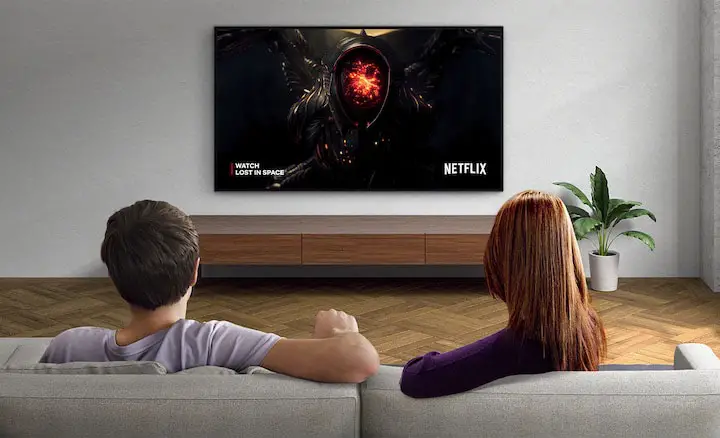
Chromecast is also available here and it gives you the ability to stream content from other Chromecast enabled devices like mobile phones and tablets directly to the TV. Voice control is also present but it seems that it is a bit limited compared to other competing models. By that we mean that although you can use the remote’s built-in microphone to give commands to Google Assistant, for Amazon Alexa you will need an external Alexa enabled device to work. Additionally there is also Sony’s Voice Search available.
We have seen the same thing in many other Sony TVs and probably this has to do with the fact that it’s using Google’s Android system and thus having Alexa built-in was not possible. With voice control you can issue various commands to the TV but functionality extends far beyond that as you can control any smart devices you have in your house also.
There is also a built-in media player available that you can use to playback various video and audio content from an external storage connected to the USB ports. Support is pretty great for a built-in player and compared to previous years we can admit that it will be able to play more files in comparison but in general don’t expect it to replace your dedicated media player box if you use one. If there is a file that is not following the usual standards it will not play it, something that a dedicated player will.
Most of our test files run without any problems and only a couple that have extremely high bitrates or feature unusual codecs failed to playback. In general it behaved as we were expecting from a built-in media player so expect this one to cover most of your needs without problems.
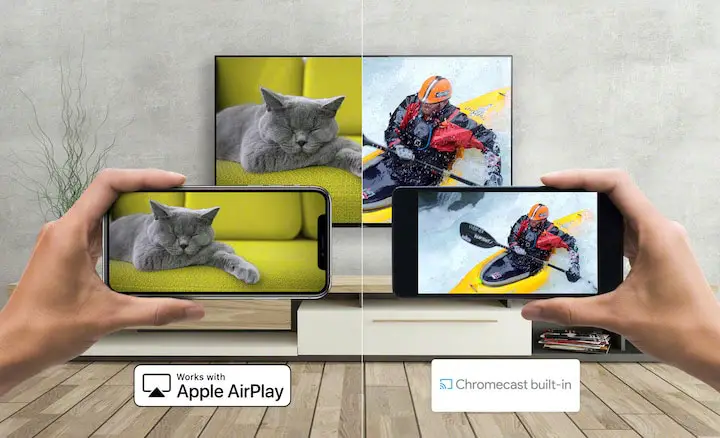
Sony has also added support for both Apple Airplay 2 and HomeKit. With Airplay 2 you can stream content from other Apple devices on your TV while HomeKit lets you control certain aspects of the TV through your mobile device. Also if you are all Apple then keep in mind that the A95K supports Apple TV which is Apple’s online streaming service in order to have the complete Apple’s suite. So in case you favor Apple’s products the A95K will certainly cover you in this respect.
For one more year all Sony TVs are Calman Ready. To address color variations from the production process, the TV is ready to use Portrait Displays’ high-performance Calman auto-calibration software.
This allows an unprecedented level of calibration and the ability to fine-tune adjustments simply not possible through conventional picture settings. It delivers high-fidelity color reproduction that’s true to the original TV signal, and can even adapt to the subtlest changes in color that may occur over time.
The A95K also comes with IMAX Enhanced certification, something that all Sony higher tier TVs do. This means it can playback IMAX Enhanced content although this is still very scarce to find. Sony is the only manufacturer out of the big three that offers some of its premium TVs with IMAX Enhanced.

As with all other Sony TVs in 2022 the major addition this year seems to be the new Bravia Cam. This an optional accessory that can be purchased separately and can further enhance the functionality of the A95K.
With the Bravia Cam the TV can detect where you sit in the room and adjust the picture and audio accordingly. Other functions include gesture control and power saving features among others.
One last thing we need to mention is that there is no official app support for controlling the TV. If you want to control the A95K using your mobile device you can use either the Android TV app made by Google that supports many of Sony’s TVs the last few years or you can download Sony’s own TV SideView app.
The A95K comes with the full feature set Sony has released in 2022 that includes plenty of online and offline features. And being the flagship release this year the A95K misses nothing, as it should be.
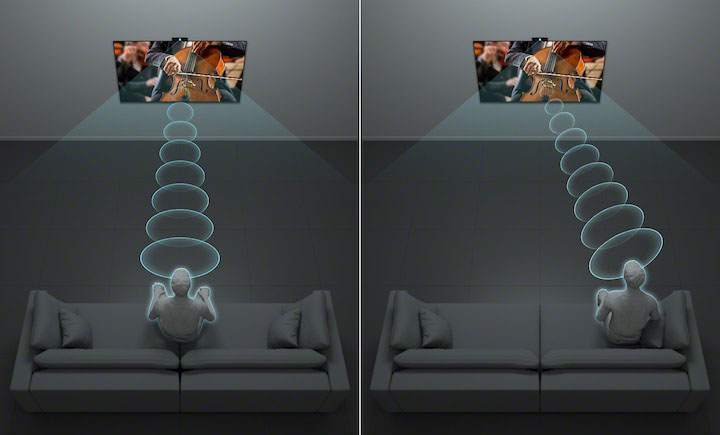
Final Thoughts
We reached the end of our analysis and we are certain that many of you will be asking if it is worth it to go for the A95K or choose the Samsung S95B instead. To be honest, things are not so complicated so we will be as direct as possible.
The Sony A95K has the most accurate image quality money can buy in 2022. If image quality is your aim and budget is no problem then sure, pay the premium and go for the Sony. On the other hand if budget is of some concern or gaming is your main focus then go for the Samsung as it is much cheaper than the Sony and comes with certain gaming features like four HDMI 2.1 ports, 144Hz support and FreeSync. It’s as simple as that.
The A95K really reminded us of the debate last year and if it was worth it to go for the Sony A90J instead of the A80J. The A90J was more expensive than the A80J and offered slightly better image quality and brightness. In the end, it’s really all about your budget and what you are willing to pay for. That is why we said that if you really want the best of the best then the A95K with its premium price is the only way to go.
Closing we will say that the Sony A95K really impressed us in terms of image quality. In terms of features it comes with the standard that many premium Sony TVs have but Sony’s first QD-OLED release is surely a major landmark and will remain the king of image quality…until we get something better the following years. From all the above we give the A95K our highest recommendation.
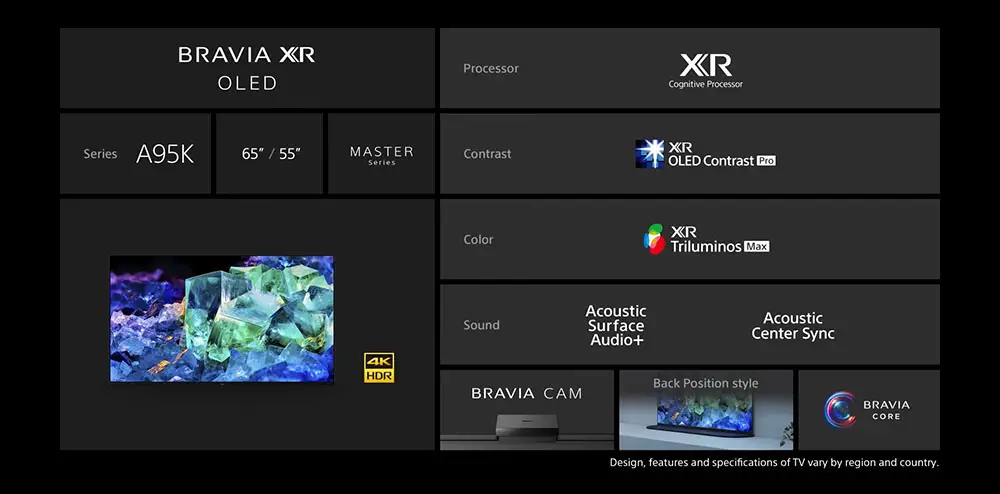
For more reviews you can check our dedicated 4K QD-OLED TV reviews list or even look at our Product Reviews Table where you can find the brand and specific product you are looking for.
Cheapest Places to Buy :
*We are a reader-supported website. When you buy through links on our site, we may earn a small affiliate commission at no extra cost to you. Home Media Entertainment does not accept money for reviews.*

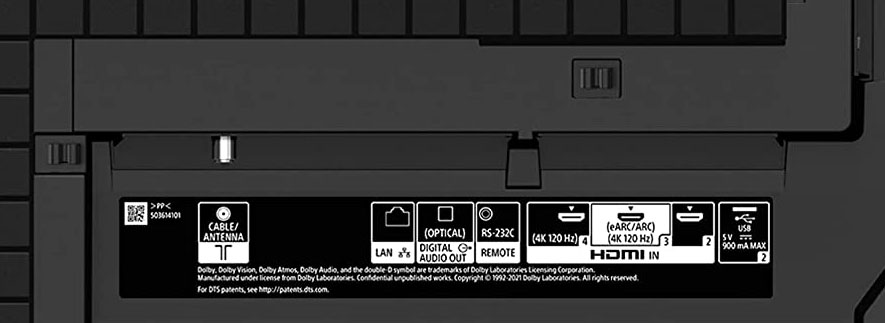
As my own house is down to its finishing touches, I am scouting for a TV set that would be perfect for our living room. Straight to the point, I prefer Sony over Samsung simply because of the picture quality. Samsung isn’t that bad but I would always prefer Sony. And your review seems to confirm what I have seen in some others, that is that the A95K is the best right now. Price is high, but this is Sony so it was to be expected.
Hello Alice. As I mentioned in my review the A95K is the best but also the most expensive. If you can afford the price and willing to pay the premium to have the best at this moment then go ahead. Otherwise the S95B is really close and at a much lower price.
I didn’t like the ironing board stand on the A95K, because it looked weird.
It would be better if all of Sony’s premium tv remotes were inspired by the B&O style remote design.
Many people didn’t like this stand. Let’s hope they will change it for their 2023 flagship.
I fully agree with you, Hope in 2023 and beyond Sony doesn’t make a pretty awful stand design.
Sony is at it again. I previously had a Sony but now I have two Samsung TVs. I really did love the Sony when I had it. I always found their picture to be better. When I’m in the market for a new tv in the coming months I’ll be sure to refer back to this article. Thanks for all the information.
Hi Jamie. Sony makes good TVs but some of them are a bit overpriced. And the A95K is the best example of that. It was the same last year with the A90J. Best image overall but when it comes to price you have to pay a hefty premium.